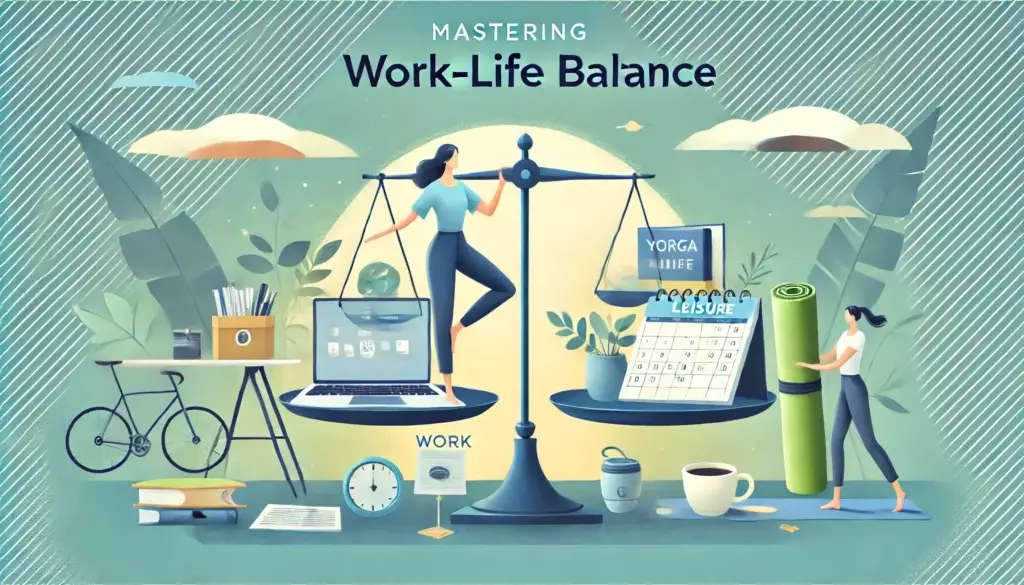In today’s fast-paced world, achieving a healthy work-life balance can be a daunting task. However, effective time management strategies can make a significant difference in how we juggle professional and personal responsibilities. By mastering these techniques, we can enhance productivity, reduce stress, and improve our overall well-being. In this article, we’ll explore a variety of strategies to help you achieve a harmonious balance between your work and personal life.
Understanding the Importance of Work-Life Balance
Work-life balance is the equilibrium between professional duties and personal activities. It ensures that neither aspect overwhelms the other, allowing us to maintain our physical and mental health. An imbalance can lead to burnout, decreased productivity, and strained relationships. Hence, it is crucial to develop skills and habits that promote a balanced lifestyle.
Setting Clear Boundaries
One of the most effective ways to manage time is by setting clear boundaries between work and personal life. This involves defining specific times for work and leisure and sticking to them.
Define Your Work Hours
Establishing a set schedule for work helps in creating a routine. Decide when you will start and end your workday and communicate these hours to your colleagues and family. This practice not only enhances productivity but also ensures you have ample time for personal activities.

Create a Dedicated Workspace
Having a designated workspace, whether at home or in an office, can significantly improve focus and efficiency. Ensure this space is free from distractions and equipped with everything you need to work effectively. A dedicated workspace helps in mentally separating work from leisure, promoting better work-life balance.
Prioritizing Tasks
Effective time management involves prioritizing tasks to ensure that important activities are completed first. This can be achieved through various methods, such as the Eisenhower Matrix, which categorizes tasks based on their urgency and importance.
The Eisenhower Matrix
The Eisenhower Matrix is a powerful tool for prioritizing tasks. It divides tasks into four categories:
- Urgent and Important: Tasks that require immediate attention.
- Important but Not Urgent: Tasks that are significant but can be scheduled for later.
- Urgent but Not Important: Tasks that need quick action but are not crucial.
- Not Urgent and Not Important: Tasks that can be postponed or eliminated.
By focusing on urgent and important tasks first, we can ensure that critical activities are addressed promptly, reducing stress and improving efficiency.
Utilizing Time Management Tools
There are numerous tools and applications designed to help manage time more effectively. These tools can assist in organizing tasks, setting reminders, and tracking progress.
Task Management Apps
Apps like Trello, Asana, and Todoist allow users to create task lists, set deadlines, and collaborate with team members. These platforms provide a visual representation of tasks, making it easier to track progress and stay organized.
Time-Tracking Software
Time-tracking tools, such as Toggl and RescueTime, monitor how much time is spent on various activities. This data can be invaluable in identifying time-wasting habits and making necessary adjustments to improve productivity.
Implementing the Pomodoro Technique
The Pomodoro Technique is a time management method that involves breaking work into intervals, traditionally 25 minutes in length, separated by short breaks. This technique helps maintain focus and prevents burnout.
How to Use the Pomodoro Technique
- Choose a Task: Select a task to work on.
- Set a Timer: Set a timer for 25 minutes.
- Work on the Task: Focus solely on the task until the timer rings.
- Take a Short Break: Take a 5-minute break to rest and recharge.
- Repeat: Repeat the process four times, then take a longer break of 15-30 minutes.
By incorporating the Pomodoro Technique into your routine, you can enhance concentration and productivity while ensuring regular breaks to rest and rejuvenate.
Delegating Tasks
Delegation is a critical skill in time management. By assigning tasks to others, we can free up time to focus on more important activities. Effective delegation involves choosing the right person for the task, providing clear instructions, and trusting them to complete it.
Identifying Tasks to Delegate
Not all tasks require your direct involvement. Identify activities that can be handled by others and delegate them accordingly. This can include administrative tasks, routine maintenance, or specialized work that others may be better suited to perform.
Effective Communication
When delegating tasks, clear communication is key. Provide detailed instructions and expectations, and ensure the person understands their responsibilities. Regular check-ins can help monitor progress and address any issues that arise.
Maintaining Work-Life Balance Through Self-Care
Self-care is an essential component of maintaining a healthy work-life balance. Taking care of your physical and mental health ensures you have the energy and resilience to manage both work and personal responsibilities effectively.
Physical Health
Maintaining good physical health is crucial for overall well-being. Regular exercise, a balanced diet, and sufficient sleep are fundamental components of a healthy lifestyle.
- Exercise: Aim for at least 30 minutes of physical activity each day. This can include walking, jogging, yoga, or any activity that gets your body moving.
- Nutrition: Eat a balanced diet rich in fruits, vegetables, lean proteins, and whole grains. Avoid excessive consumption of processed foods, sugar, and caffeine.
- Sleep: Ensure you get 7-9 hours of sleep each night. Establish a bedtime routine to promote better sleep quality.
Mental Health
Mental health is equally important as physical health. Engaging in activities that promote relaxation and mental clarity can significantly enhance your ability to manage stress and maintain focus.
- Mindfulness and Meditation: Practices like mindfulness and meditation can help reduce stress and improve mental clarity. Set aside a few minutes each day to practice deep breathing or meditation.
- Hobbies and Interests: Engage in hobbies and activities that you enjoy. Whether it’s reading, painting, gardening, or playing a musical instrument, these activities can provide a much-needed break from work-related stress.
- Social Connections: Maintain strong social connections with family and friends. Spending time with loved ones can provide emotional support and help you recharge.
Balancing Work and Personal Life
Achieving a work-life balance requires continuous effort and adjustment. By implementing effective time management strategies and prioritizing self-care, we can create a harmonious balance that enhances our quality of life.
Set Realistic Goals
Setting realistic goals is essential for managing expectations and avoiding burnout. Break down larger tasks into smaller, manageable steps and celebrate your achievements along the way. This approach helps maintain motivation and provides a clear roadmap to success.
Learn to Say No
Learning to say no is a crucial skill in maintaining work-life balance. Overcommitting can lead to stress and burnout. Evaluate your commitments and prioritize tasks that align with your goals and values. Politely decline tasks that do not fit into your schedule or contribute to your objectives.
Embrace Flexibility
Flexibility is key to managing the unpredictability of life. While having a structured schedule is important, it’s equally important to adapt to changes and unexpected events. Embrace flexibility by allowing room for adjustments in your plans and being open to new opportunities.
Conclusion
Effective time management is the cornerstone of a healthy work-life balance. By setting clear boundaries, prioritizing tasks, utilizing time management tools, and prioritizing self-care, we can create a balanced and fulfilling lifestyle. Remember, achieving work-life balance is an ongoing process that requires continuous effort and adjustment. By implementing these strategies, we can enhance our productivity, reduce stress, and enjoy a harmonious balance between our professional and personal lives.




